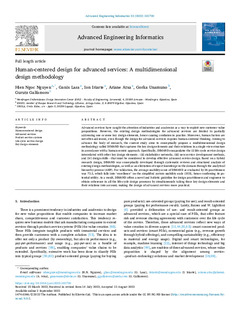
Izenburua
Human-centered design for advanced services: A multidimensional design methodologyArgitalpen data
2022Beste erakundeak
Ideko (Spain)Urola
Bertsioa
Bertsio argitaratuaDokumentu-mota
ArtikuluaArtikuluaHizkuntza
IngelesaEskubideak
© 2022 The AuthorsSarbidea
Sarbide irekiaArgitaratzailearen bertsioa
https://doi.org/10.1016/j.aei.2022.101720Non argitaratua
Advanced Engineering Informatics Vol. 53. Article 101720. August, 2022Argitaratzailea
ElsevierGako-hitzak
human-centred design
Advanced services
Product-service systems
Life-cycle service design ... [+]
Advanced services
Product-service systems
Life-cycle service design ... [+]
human-centred design
Advanced services
Product-service systems
Life-cycle service design
Key design elements [-]
Advanced services
Product-service systems
Life-cycle service design
Key design elements [-]
Laburpena
Advanced services have caught the attention of industries and academics as a way to exploit new customer value propositions. However, the existing design methodologies for advanced services are limite ... [+]
Advanced services have caught the attention of industries and academics as a way to exploit new customer value propositions. However, the existing design methodologies for advanced services are limited to partially addressing one or some key design elements, hence causing confusion in practice. Moreover, human factors are not often addressed, even though the design for advanced services requires human-centered thinking. Aiming to advance the body of research, the current study aims to conceptually propose a multidimensional design methodology called DIMAND that captures the key design elements and their relations in a single-view structure in accordance with a human-centric approach. Specifically, DIMAND encapsulates the (i) life-cycle service design interrelated with other key design elements—(ii) stakeholder networks, (iii) new service development methods, and (iv) design skills—that must be considered to develop effective advanced service design. Based on a hybrid research design, DIMAND was conceptually developed through systematic reviews and structured analysis of existing design methodologies, as well as an elicitation of expert knowledge in the domain through the analytical hierarchy process (AHP). For validation, the average usability score of DIMAND as evaluated by 26 practitioners was 72.2, which falls into “excellence” on the simplified system usability scale (SUS), hence confirming its potential utility. As a result, DIMAND offers a novel and holistic guideline for design practitioners and engineers to obtain coherence in all the life-cycle design processes by simultaneously taking these key design elements and their relations into account, making the design of advanced services more practical. [-]
Sponsorship
Comisión EuropeaProjectu ID
info:eu-repo/grantAgreement/EC/H2020/814078/EU/Digital Manufacturing and Design Training Network/DiManDBildumak
Item honek honako baimen-fitxategi hauek dauzka asoziatuta:
Bestelakorik adierazi ezean, itemaren baimena horrela deskribatzen da: Attribution-NonCommercial-NoDerivatives 4.0 International
Related items
Showing items related by title, author, creator and subject.
-
DC distribution grids: Providing comprehensive tools for a more efficient and reliable design
Mondragon Unibertsitatea (Mondragon Unibertsitatea, 2017-10-10)Researchers from Mondragon Unibertsitatea along with representatives from Ingeteam, S.A. offered atutorial about the most recent research related to the development of DC distribution grids at the European Conference on ... -
“Creativity in Design” Lehenengo jardunaldia.
Mondragon Unibertsitatea (Mondragon Unibertsitatea, 2010-11-25)Mondragon Unibertsitateko Goi Eskola Politeknikoan diseinuko sormen jardunaldia. -
Design Konferentziak Mondragon IV. edizioa
Mondragon Unibertsitatea (Mondragon Unibertsitatea, 2014-07-10)Ekainak 13an, Bilbao Berrikuntza Faktoriako eraikuntza berrian izan zen konferentzia.





















